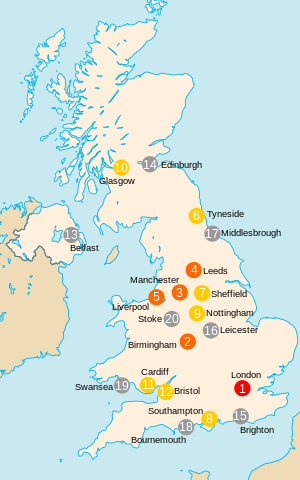
A 2001 ESPIN metropolitan area was defined as consisting of an urban area, conurbation or agglomeration, together with the surrounding area to which it was closely economically and socially integrated through commuting.
The European Union's ESPON (European Spatial Planning Observation Network) project defined a harmonised series of metropolitan areas across Europe, made up of two components: Morphological Urban Areas (MUAs), which were similar to urban areas that form the densely populated urban cores of metropolitan areas, and Functional Urban Areas (FUAs), which form the labour basin surrounding Morphological Urban Areas.[1]
Morphological Urban Areas were calculated by combining contiguous local administrative units with population densities greater than 650 inhabitants per square kilometre, with Functional Urban Areas then being calculated by combining surrounding local administrative units where 10% or more of the workforce works within the core Morphological Urban Area.[2]
According to the harmonised European definition, there were eighteen metropolitan areas in the United Kingdom with populations of more than 500,000 at the time of the 2001 census.
This article lists the UK metropolitan areas defined by ESPON, which excluded combined conurbations such as the Liverpool-Manchester megalopolis, which (in 2001) had a combined population of 5.6 million.[3] It also excluded city regions such as those formed in Greater Manchester, Leeds, Liverpool and Sheffield, which are typically areas now covered by combined authorities.
- ^ "MUAs and FUAs delineation" (PDF). ESPON project 1.4.3 Study on Urban Functions. European Spatial Planning Observation Network. March 2007. p. 8. Retrieved 22 February 2010.
- ^ "The methodology" (PDF). ESPON project 1.4.3 Study on Urban Functions. European Spatial Planning Observation Network. March 2007. p. 17. Retrieved 22 February 2010.
- ^ Schulze Bäing, Andreas. "Shrinking cities and growing regions – emerging trends of new rural-urban relationships in the UK and Germany". 13 July. AESOP University of Manchester. Retrieved 19 March 2015.